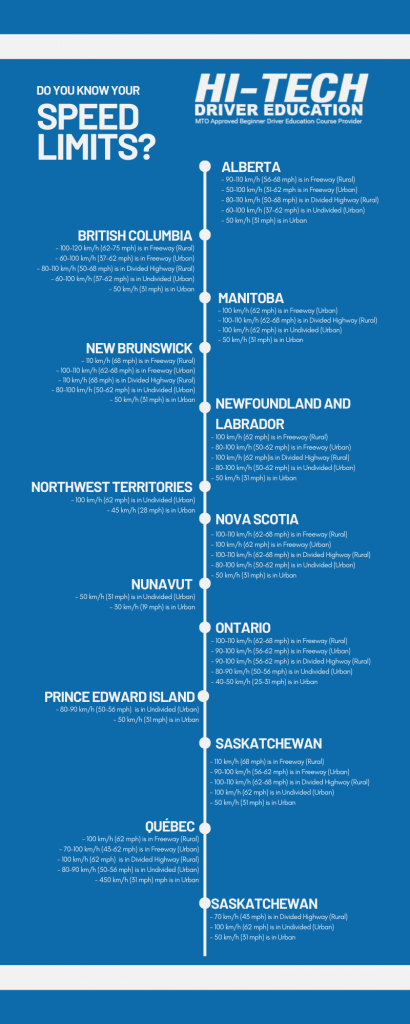Today we are together on a new Hi-Tech Driver Education blog. We continue to provide education in Ontario with licensed driving instructors. Our last article talked about the 12 Most Common Mistakes to Avoid in the Driving Test. Today we will talk about speed limits. At the end of our blog, we have reserved a section for provinces other than the province of Ontario. You can find out the speed limits of the states in the infographic below. So let’s keep reading.
Anyone who read last week’s blog post knows that going too slow or too fast is dangerous. If speed limits are not set, the speed limit is 50 km/h in the city and 80 km/h in towns and villages and elsewhere. In recent years, the province of Ontario has decided to pursue a policy of increasing speed limits on its highways.
Ontario has now nearly completed most of this project. It has increased speed limits to 110 km/h on the following three 400 series highways:
- Hamilton to St. To Queen Elizabeth Road and Catharines (32 km)
- Highway 402 from Sarnia to London (90 km)
- Highway 417 from Gloucester (east of Ottawa) to the Ontario-Quebec border (102 km)
More than eight thousand people participated in the survey, which was launched at an equivalent time due to the project in September 2019. Survey results show 80 percent support for government regulation project implementation and 82 percent support raising immediate limits in more departments.
There are currently six other states in Canada that have set speed limits of 110 km/h or higher on certain highways. Ontario’s highways are among the safest in North America. They have been ranked as the lowest or second-lowest fatality rate of all-time among all jurisdictions for 18 consecutive years.
If we don’t follow the speed limits, we will face the consequences. There are certain penalties if you exceed the speed limit. These speed limits are fines;
- Above 0-15 km/h limit: good but no fault points
- Above 16-29 km/h limit: fine + 3 penalty points
- Above 30-49 km/h limit: fine + 4 penalty points (G1, G2, M1 and M2, 30-day novice driver may be suspended upon conviction)
- Above 50km/h limit and above: Arrested for Searching several people for Stuntman and/or Speeding and/or Reckless Driving. Minimum $2,000 fine + 6 penalty points (G1, G2, M1 and M2 can be 30-day novice driver suspension upon conviction, as well as court-ordered penalties).
I’m sure you don’t want to face these consequences. It can have more significant effects, such as legal consequences for not obeying speed limits. As a result of research conducted in 2020, 27% of traffic accidents on Canadian roads directly result from acceleration. We mentioned that not obeying speed limits will cause a significant risk of injury and death. Higher speeds add to the risk of major injury and death in three ways:
- Higher driving speeds reduce drivers’ visibility and, therefore, situational awareness, crucial for predicting and reacting to unexpected events or sudden changes in road conditions.
- The higher the speed, the greater the stopping distance required when braking and, as a result, the greater the risk of collision.
- If a collision does occur, an impression at higher speeds will cause more severe blunt force trauma on the victims as more mechanical energy has to be absorbed. The effect is most pronounced for vulnerable road users without protection.
So let’s briefly go over the speed limits for Ontario for the last time and talk about other states.
In 1977, highways began using the weight and measure system, and speeds were slightly increased to the maximum, starting from 80 to 100 km/h (50 to 62 mph).
In 2013, “speed too fast / exceeding speed limit” contributed to 18.4% of all crashes, while “speed” accounted for 55.2% of driving convictions.
In 2015, the Ontario government unveiled the idea of scaling residential speed limits back from the statutory default of 50 km/h, either by reducing the legal limit to 40 km/h or giving municipalities the option to set their own legal speed limits. By allowing posted speed limits in class zones to be reduced to 30 km/h.
On September 26, 2019, during a two-year trial, speed limits were increased from 100 km/h (62 mph) to 110 km/h (68 mph) as part of a pilot along Highway 402 from London to Sarnia ( 90 km), St. Catharines/Lincoln to Hamilton (32 km) and Highway 417 (102 km) from Ottawa/Gloucester to the Ontario/Quebec border.
Finally, below is the infographic we created for you in our article, and you can learn the speed limits. Let’s obey the speed limits, let’s drive by obeying the speed limits for our loved ones and ourselves. Have a nice drive.
Speed Limits By Province:








